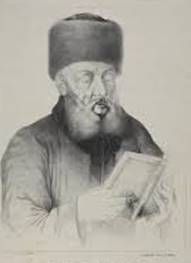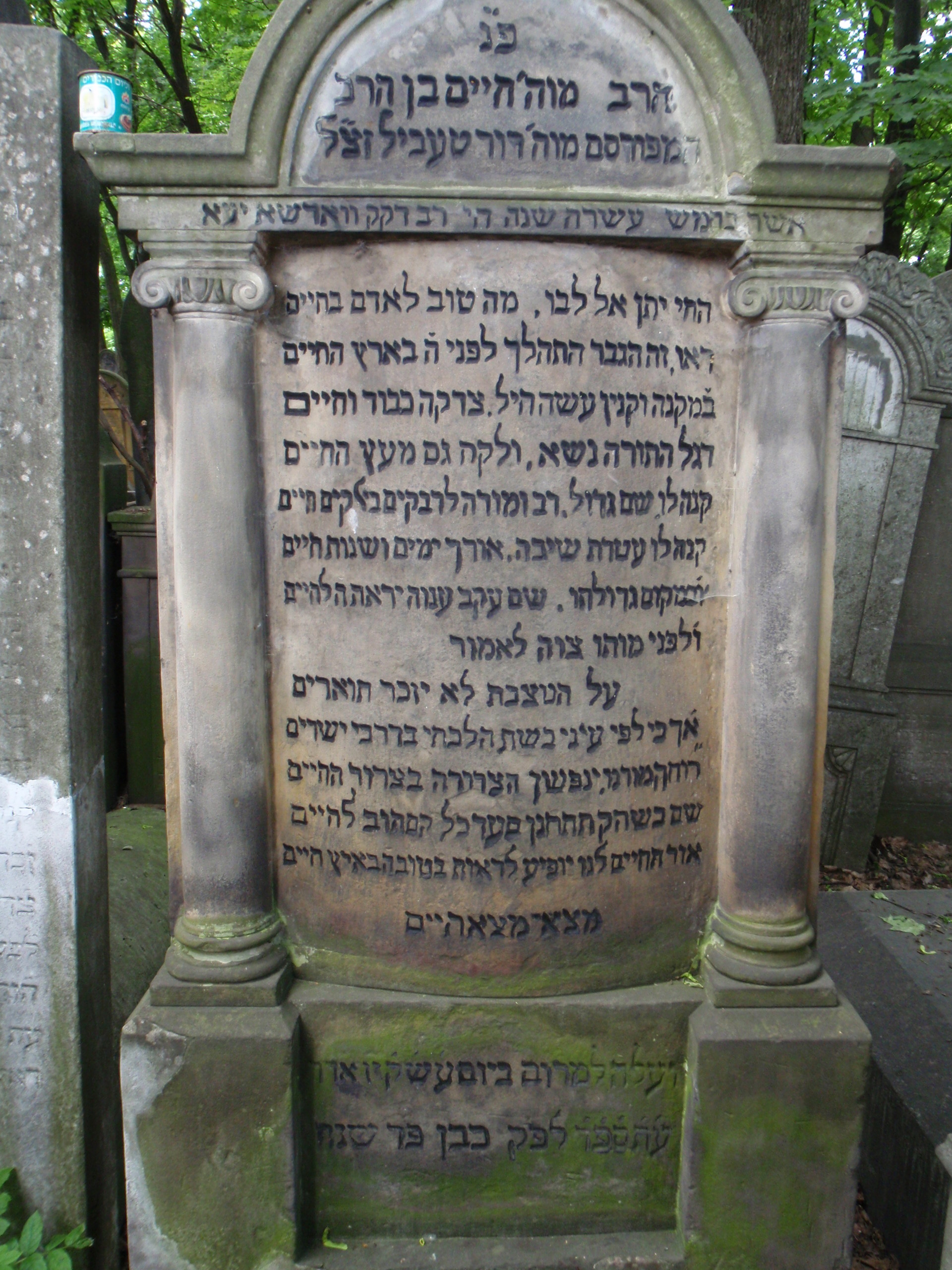Chaim Davidsohn on:
[Wikipedia]
[Google]
[Amazon]
Rabbi Chaim Davidsohn (1760, 
 When Chief Rabbi Lipszyc died in 1839, Rabbi Davidsohn proposed Rabbi
When Chief Rabbi Lipszyc died in 1839, Rabbi Davidsohn proposed Rabbi
Pińczów
Pińczów is a town in southern Poland, in Świętokrzyskie Voivodeship, about 40 km south of Kielce. It is the capital of Pińczów County. Population is 12,304 (2005). Pińczów belongs to the historic Polish province of Lesser Poland, an ...
- 1854, Warsaw
Warsaw ( pl, Warszawa, ), officially the Capital City of Warsaw,, abbreviation: ''m.st. Warszawa'' is the capital and largest city of Poland. The metropolis stands on the River Vistula in east-central Poland, and its population is officia ...
) was the second Chief Rabbi
Chief Rabbi ( he, רב ראשי ''Rav Rashi'') is a title given in several countries to the recognized religious leader of that country's Jewish community, or to a rabbinic leader appointed by the local secular authorities. Since 1911, through a ...
of Warsaw.

Early years
He was born in 1760 to Rabbi David Tebele, from whom he orphaned at an early age. In his youth he became known as anillui
''Illui'' ( he, עילוי or עלוי also ilui; pronounced plural: ''illuim'') is a young Torah and Talmudic prodigy or genius. The Hebrew term and title is applied to exceptional Talmudic scholars among Orthodox Jews. It is used among Engli ...
, and studied Torah under Rabbi David Tebele of Lissa and, according to some sources, Rabbi Yaakov Lorberbaum
Yaakov ben Yaakov Moshe Lorberbaum of Lissa (1760-1832) (known in English as Jacob ben Jacob Moses of Lissa, Jacob Lorberbaum or Jacob Lisser, Hebrew: יעקב בן יעקב משה מליסא) was a rabbi and posek. He is most commonly known as the ...
of Lissa.
At the age of 13 he married Rachel, the daughter of the wealthy Naftali Zvi Tsenzminer. After his marriage, he lived in his father-in-law's house in Warsaw, and continue to study Torah
The Torah (; hbo, ''Tōrā'', "Instruction", "Teaching" or "Law") is the compilation of the first five books of the Hebrew Bible, namely the books of Genesis, Exodus, Leviticus, Numbers and Deuteronomy. In that sense, Torah means the s ...
as stipulated by his father-in-law.
After the death of his father-in-law in 1811, he entered into his father-in-law's family business, alongside his wife's brother Israel Hirschensohn, while continuing to study Torah with Rabbi Shlomo Eiger (Israel's son-in-law).
Community leader
He became involved in community affairs, and eventually was considered the seniorshtadlan
A ''shtadlan'' ( he, שַׁדְלָן, ; yi, wikt:שתּדלן#Yiddish, שתּדלן, ) was an intercessor for a local History of the Jews in Europe, European Jewish community. They represented the interests of the community, especially those of ...
of the Warsaw Jewish community, with his signature appearing on proclamations of the Jewish community council (). He served as supervisor ("mashgiach") of the Jewish community council (vaad) for two years, and the Chief Rabbi of Warsaw, Rabbi Szlomo Zalman Lipszyc
Szlomo Zalman Lipszyc (1765 Poznań - 1839 Warsaw), also known as Salomon Zalman Pozner as well as the Chemdas Shlomo from the title of the works he authored, was a prominent Orthodox rabbi, and first Chief Rabbi of Warsaw.
He studied Torah in ...
would consult with him on public affairs.
He supported the November Uprising
The November Uprising (1830–31), also known as the Polish–Russian War 1830–31 or the Cadet Revolution,
was an armed rebellion in the heartland of partitioned Poland against the Russian Empire. The uprising began on 29 November 1830 in W ...
of 1830-1831 against the Russian Empire
The Russian Empire was an empire and the final period of the Russian monarchy from 1721 to 1917, ruling across large parts of Eurasia. It succeeded the Tsardom of Russia following the Treaty of Nystad, which ended the Great Northern War. ...
and raised funds for the rebels. He opposed Jews joining the rebel forces because that necessitated that they shave their beards and payot
''Pe'ot'', anglicized as payot ( he, פֵּאוֹת, pēʾōt, "corners") or payes (), is the Hebrew term for sidelocks or sideburns. Payot are worn by some men and boys in the Orthodox Jewish community based on an interpretation of the Tanakh's ...
, while at the same time he appealed to the rebel leadership to drop that requirement.
In opposition to Chief Rabbi Lipszyc, and the leader of Warsaw's Hassidim
Ḥasīd ( he, חסיד, "pious", "saintly", "godly man"; plural "Hasidim") is a Jewish honorific, frequently used as a term of exceptional respect in the Talmudic and early medieval periods. It denotes a person who is scrupulous in his observ ...
, Rabbi Yitzchak Meir Alter
Yitzchak Meir Rotenberg-Alter ( yi, יצחק מאיר אלטער, pl, Icchak Meir Rothenberg Alter, he, יצחק מאיר אלתר) (1799 – 10 March 1866), was the first Rebbe of the Ger Hasidic dynasty, which he founded in the town of G� ...
of Ger, he supported the establishment of the Szkoła Rabinów w Warszawie (Warsaw Rabbinical School
Warsaw Rabbinical School (Warszawska Szkoła Rabinów) was a Junior High School for Jewish male youth established in 1826 on the basis of the ukase of the Nicholas I of Russia, emperor Nicholas of July 1, 1825 and existed until the school year 186 ...
) in 1826, despite its association with the Haskala
The ''Haskalah'', often termed Jewish Enlightenment ( he, השכלה; literally, "wisdom", "erudition" or "education"), was an intellectual movement among the Jews of Central and Eastern Europe, with a certain influence on those in Western Euro ...
, relying on its nominal leader, the traditionalist Rabbi Avraham Yaakov Stern, to keep the seminary within the bounds of traditional Orthodoxy
Orthodoxy (from Greek: ) is adherence to correct or accepted creeds, especially in religion.
Orthodoxy within Christianity refers to acceptance of the doctrines defined by various creeds and ecumenical councils in Antiquity, but different Churc ...
. However, a few years later withdrew his support, claiming that it did not practice Orthodoxy.
He founded a cheder
A ''cheder'' ( he, חדר, lit. "room"; Yiddish pronunciation ''kheyder'') is a traditional primary school teaching the basics of Judaism and the Hebrew language.
History
''Cheders'' were widely found in Europe before the end of the 18th ...
for the children of the poor and raised funds for the Jewish community In Erez Israel, in particular for Kollel Polin. After the Galilee earthquake of 1837
The Galilee earthquake of 1837, often called the Safed earthquake, shook the Galilee on January 1 and is one of a number of moderate to large events that have occurred along the Dead Sea Transform (DST) fault system that marks the boundary of t ...
, he raised large sums which were clandestinely transferred to hard hit Safed
Safed (known in Hebrew language, Hebrew as Tzfat; Sephardi Hebrew, Sephardic Hebrew & Modern Hebrew: צְפַת ''Tsfat'', Ashkenazi Hebrew pronunciation, Ashkenazi Hebrew: ''Tzfas'', Biblical Hebrew: ''Ṣǝp̄aṯ''; ar, صفد, ''Ṣafad''), i ...
by Moses Montefiore
Sir Moses Haim Montefiore, 1st Baronet, (24 October 1784 – 28 July 1885) was a British financier and banker, activist, philanthropist and Sheriff of London. Born to an Italian Sephardic Jewish family based in London, afte ...
.
Chief Rabbi of Warsaw
David Luria
David Luria (1798–1855) was a rabbi, commentator, and linguist, one of the greatest Torah scholars in his generation. He authored commentaries on the Babylonian Talmud and Pirkei de-Rabbi Eliezer.
Biography
He was born to a wealthy family in Byk ...
as his replacement, while the Hassidim advocated for Rabbi Alter. However, the majority of the community council wanted Rabbi Davidsohn, despite his age (about 80 years) and despite not serving previously in a rabbinical position. He initially refused, but eventually accepted the appointment. He moved to the Chief Rabbi's official residence and founded a Yeshiva
A yeshiva (; he, ישיבה, , sitting; pl. , or ) is a traditional Jewish educational institution focused on the study of Rabbinic literature, primarily the Talmud and halacha (Jewish law), while Torah and Jewish philosophy are s ...
.
During his tenure, halachic
''Halakha'' (; he, הֲלָכָה, ), also transliterated as ''halacha'', ''halakhah'', and ''halocho'' ( ), is the collective body of Jewish religious laws which is derived from the written and Oral Torah. Halakha is based on biblical commandm ...
questions from throughout Poland were addressed to him, but, out of modesty, before his passing he burned his rabbinical responsa
The history of '' responsa'' in Judaism (Hebrew: שאלות ותשובות; Sephardic: ''She'elot Utshuvot''; Ashkenazic: ''Sheilos Utshuvos;'', usually shortened to שו"ת Shu"t ), spans a period of 1,700 years. Rabbinic responsa constitute a ...
and novellae In Roman law, a novel ( la, novella constitutio, "new decree"; gr, νεαρά, neara) is a new decree or edict, in other words a new law. The term was used from the fourth century AD onwards and was specifically used for laws issued after the publi ...
to prevent them from being published.
He died on the 14th day of Adar
Adar ( he, אֲדָר ; from Akkadian ''adaru'') is the sixth month of the civil year and the twelfth month of the religious year on the Hebrew calendar, roughly corresponding to the month of March in the Gregorian calendar. It is a month of 29 d ...
at the age of 94 and was buried in the Jewish cemetery in Warsaw
Jewish cemeteries of Warsaw refers to a number of Jewish necropolises in the city.
Okopowa Street Jewish Cemetery
Okopowa Street Jewish Cemetery is one of the largest Jewish cemeteries in Europe. Located on Okopowa Street and abutting the Powązk ...
, near the grave of his predecessor, Rabbi Lipszyc. He was succeeded as Chief Rabbi of Warsaw by Rabbi Dow Ber Meisels
Dow (Dov, Dob) Ber (Beer, Berisz, Berush) Meisels (1798 – 17 March 1870) was a Chief Rabbi of Kraków (Cracow) from 1832 and later, Chief Rabbi of Warsaw (from 1856). He was active in the Polish nationalist movement, and was a politician in the ...
.
Family
His eldest son, Rabbi Avraham Abeli Davidsohn, served as rabbi of Biala and died at an early age. The rest of his sons were merchants and activists in the Jewish community. as well as being scholars. His son Naftali was very wealthy, and served as amohel
A ( he, מוֹהֵל , Ashkenazi pronunciation , plural: , arc, מוֹהֲלָא , "circumciser") is a Jew trained in the practice of , the "covenant of circumcision".
Etymology
The noun ( in Aramaic), meaning "circumciser", is derived fro ...
, shofar
A shofar ( ; from he, שׁוֹפָר, ) is an ancient musical horn typically made of a ram's horn, used for Jewish religious purposes. Like the modern bugle, the shofar lacks pitch-altering devices, with all pitch control done by varying the ...
blower, and Torah reader in Warsaw.
{{DEFAULTSORT:Davidsohn, Chaim
1854 deaths
1760 births
19th-century Polish rabbis
Clergy from Warsaw